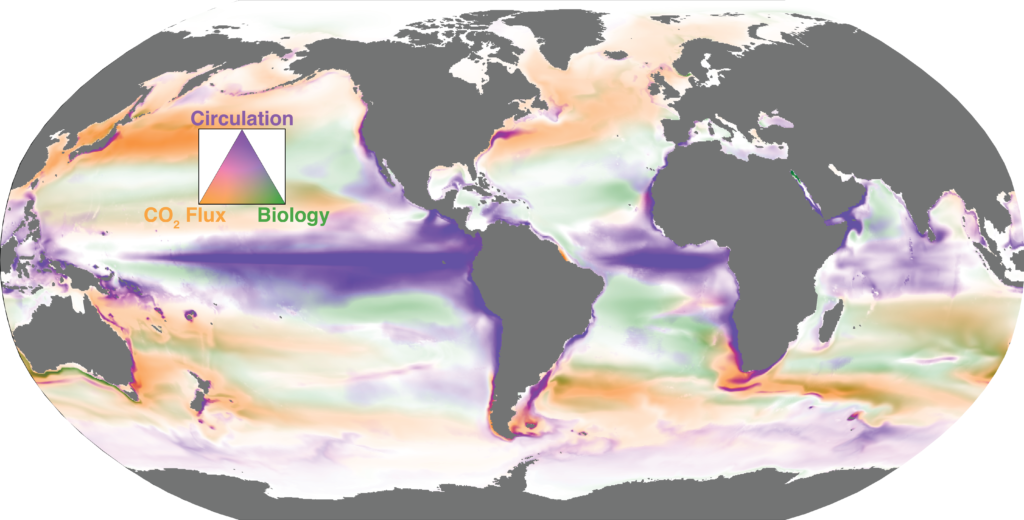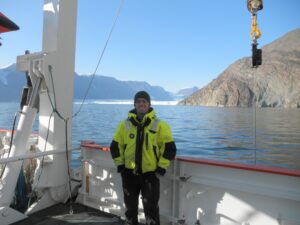
story by Dustin Carroll and Helen Hill for MITgcm
This month we spotlight work to generate a global-ocean, data-constrained DIC (dissolved inorganic carbon) budget using the new ECCO-Darwin ocean biogeochemistry state estimate.
The ocean has absorbed roughly 40% of fossil fuel carbon dioxide (CO2) emissions since the beginning of the industrial era. This so-called “ocean carbon sink,” which primarily sequesters emissions in the form of dissolved inorganic carbon (DIC), plays a key role in regulating climate and mitigating global warming. However, scientists still lack a mechanistic understanding of how physical, chemical, and biological processes impact the ocean DIC reservoir in both space and time, and hence how ocean storage rates of carbon emissions may change in the future.
Data-driven estimates of how much CO2 the ocean is absorbing (the so-called “ocean carbon sink”) have improved substantially in recent years. However, computational ocean models that include biogeochemistry continue to play a critical role as they allow us to isolate and understand the individual processes that control ocean carbon sequestration. The ideal scenario is a combination of the above two methods, where data are ingested and then used to improve a model’s fit to the observed ocean, also known as, data assimilation.
While the physical oceanographic community has made great strides in developing data assimilation systems, for example, the Estimating the Circulation and Climate of the Ocean (ECCO) consortium, the biogeochemical community has generally lagged behind. Now by fusing the Darwin model (the highly-realistic ecosystem model that has emerged from the MIT Darwin Project) with ECCO to form ECCO-Darwin, scientists have the ability, for the first time, to ingest both physical and biogeochemical observations into a global biogeochemical model in a realistic manner — which allows them to better understand how the nature of the ocean carbon sink has changed over multiple decades. Both models, Darwin and ECCO, are built with the MITgcm!
A recent paper co-authored by its developers (among them many well-known MITgcm aficionados) uses ECCO-Darwin to ingest both physical and biogeochemical observations to improve its accuracy, and with it, map how ocean circulation, air-sea CO2 exchange, and marine ecosystems have modulated the combined natural and anthropogenic ocean DIC budget for 1995–2018.
Foremost among their results, the team found that in the upper ocean, circulation provides the largest supply of DIC while biological processes drive the largest loss. “We found year-to-year changes in the ocean carbon sink to be dominated by El Niño-Southern Oscillation events in the equatorial Pacific Ocean, which then affect DIC globally,” says lead author Dustin Carroll (Modeling Melting Glaciers).
Carroll sees the team’s new data-constrained, global-ocean DIC budget as a significant step forward toward a better understanding of climate-related changes to the ocean carbon cycle and marine life. ”Our results give us a novel, data-constrained framework for an improved mechanistic understanding of natural and anthropogenic perturbations to the ocean sink,” he says. We are now using ECCO-Darwin to better understand how Arctic and Antarctic ecosystems are responding to climate change, the role of rivers in delivering nutrients and carbon to the open ocean, and how marine geoengineering can help mitigate climate warming.
WATCH Carroll’s presentation about this work at OSM22
Story image: Climatological ternary map for the upper 100 m of the ocean showing blended DIC gain from ocean circulation (purple colors), air-sea CO2 flux (orange colors), and net biology (green colors) – image: courtesy of the researchers.
About the Researcher

Dustin Carroll
Dustin Carroll is a physical oceanographer and data scientist who uses state-of-the-art numerical ocean models and observations to advance our understanding of how freshwater, ice, and biogeochemical systems interact with coastal and large-scale ocean circulation. Carroll is the lead developer of the NASA-funded ECCO-Darwin ocean biogeochemistry model and has conducted extensive fieldwork in Antarctica, the Alaskan Arctic, and Greenland. He cares deeply about conserving our oceans and communicating science in a way that connects people with pertinent issues in our changing climate. Carroll is a project director at Moss Landing Marine Laboratories and an affiliate scientist at the Jet Propulsion Laboratory. He has been using MITgcm since 2015.
About ECCO-Darwin
For more detail about ECCO-Darwin and the scientific questions it is being used to address see NASA’s recently published StoryMap “How do you Build the World’s Best Ocean Carbon Model?”
This Month’s Featured Publication
- Dustin Carroll, Dimitris Menemenlis, Stephanie Dutkiewicz, Jonathan M. Lauderdale, Jess F. Adkins, Kevin W. Bowman, Holger Brix, Ian Fenty, Michelle M. Gierach, Chris Hill, Oliver Jahn, Peter Landschützer, Manfredi Manizza, Matt R. Mazloff, Charles E. Miller, David S. Schimel, Ariane Verdy, Daniel B. Whitt, Hong Zhang (2022), Attribution of space-time variability in global-ocean dissolved inorganic carbon, Global Biogeochemical Cycles, doi: 10.1029/2021GB007162
Related Publication
- Carroll, D., D. Menemenlis, J.F. Adkins, K.W. Bowman, H. Brix, S. Dutkiewicz, I. Fenty, M.M. Gierach, C. Hill, O. Jahn, P. Landschutzer, J.M. Lauderdale, J. Liu, M. Manizza, J.D. Naviaux, C. Rodenbeck, D.S. Schimel, T.V. Stocken and H. Zhang (2020): The ECCO-Darwin Data Assimilative Global Ocean Biogeochemistry Model: Estimates of Seasonal to Multidecadal Surface Ocean pCO2 and Air-Sea CO2 Flux. Journal of Advances in Modeling Earth Systems, doi: 10.1029/2019MS001888
Other New Publications last month
Bailey, S. T., Jones, C. S., Abernathey, R. P., Gordon, A. L., and Yuan, X. (2022), Water mass transformation variability in the Weddell Sea in Ocean Reanalyses, EGUsphere [preprint], doi:10.5194/egusphere-2022-129, 2022
Yuanjie Chen et al (2022), Interannual Variations of Heat Budget over the Eastern Ross Sea Shelf and the Forcing Mechanisms, Research Square (under review for Climate Dynamics), doi: 10.21203/rs.3.rs-1551617
Andrew Delman and Felix Landerer (2022), Downscaling Satellite-Based Estimates of Ocean Bottom Pressure for Tracking Deep Ocean Mass Transport, Ocean Remote Sensing, doi: 10.3390/rs14071764
Eleonora de Sabata et al (2022), Marine monitoring by SCUBA divers reveals new aspects of the temperature variability inside the Gulf of Naples (Tyrrhenian Sea), Estuarine, Coastal and Shelf Science, doi: 10.1016/j.ecss.2022.107864
Hugo Frezat et al (2022), A posteriori learning for quasi-geostrophic turbulence parametrization, JAMES (submitted), arXiv: 2204.03911 [physics.flu-dyn]
Kajanto, K. and Nisancioglu, K.: Icebergs slow glacier retreat in a Greenland fjord, EGU General Assembly 2022, Vienna, Austria, 23–27 May 2022, EGU22-8336, doi: 10.5194/egusphere-egu22-8336
Wanying Kang and Malte Jansen (2022), In Icy Ocean Worlds, Size matters!, arXiv:2203.16625 [astro-ph.EP]
Scott, W., Kramer, S., Yeager, B., Holland, P., Nicholls, K. W., Siegert, M., and Piggott, M.: First steps for a 3d flexible, unstructured finite element ocean model for flow under ice shelf cavities: an ISOMIP+ case study, EGU General Assembly 2022, Vienna, Austria, 23–27 May 2022, EGU22-6500, doi: 10.5194/egusphere-egu22-6500
Le Sommer, J. and the SWOT Adopt-A-Crossover Ocean Model Intercomparison Project Team (2022), Intercomparison of basin-to-global scale submesoscale-permitting ocean models at SWOT cross-overs, EGU General Assembly 2022, Vienna, Austria, 23–27 May 2022, EGU22-11729, doi: 10.5194/egusphere-egu22-11729
Fanglou Liao, Guandong Gao, Peng Zhan, Yan Wang (2022), Seasonality and trend of the global upper-ocean vertical velocity over 1998–2017, Science Direct, doi: 10.1016/j.pocean.2022.102804
Charles Light et al (2022), Effects of grid spacing on high-frequency precipitation variance in coupled high-resolution global ocean–atmosphere models, Climate Dynamics, doi: 10.1007/s00382-022-06257-6
Manucharyan, G.E., Thompson, A.F. (2022), Heavy footprints of upper-ocean eddies on weakened Arctic sea ice in marginal ice zones, Nat. Commun., doi: 10.1038/s41467-022-29663-0
Alok Kumar Mishra, Aditya Kumar Dubey, Sushant Das (2022), Identifying the changes in winter monsoon characteristics over the Indian subcontinent due to Arabian Sea warming, Atmospheric Research, doi: 10.1016/j.atmosres.2022.106162
Alok Kumar Mishra et al (2022), Demonstrating the asymmetry of the Indian Ocean Dipole response in regional earth system model of CORDEX-SA, Atmospheric Research, doi: 10.1016/j.atmosres.2022.106182
Irene Nadal et al (2022), Hydrodynamic connectivity and dispersal patterns of a transboundary species (Pagellus bogaraveo) in the Strait of Gibraltar and adjacent basins, Fisheries and Oceanography, doi: 10.1111/fog.12583
Qihua Peng et al (2022), Surface warming–induced global acceleration of upper ocean currents, Science Advances, doi: 10.1126/sciadv.abj8394
Jianhuang Qin et al (2022), Modulation of the Intraseasonal Chlorophyll-a Concentration in the Tropical Indian Ocean by the Central Indian Ocean Mode, Geophysical research letters, doi: 10.1029/2022GL097802
Rippeth, T & Fine, E (2022), Turbulent mixing in a changing Arctic Ocean, Oceanography, doi: 10.5670/oceanog.2022.103
Nina Robbins-Blanch et al (2022), Cloudy and Cloud-free Thermal Phase Curves with PICASO: Applications to WASP-43b, arXiv: 2204.03545 [astro-ph.EP]
Mousumi Sarkar et al (2022), Sensitivity analysis of vertical mixing schemes in a regional domain using modular Ocean model, ISH Journal of Hydraulic Engineering, doi: 10.1080/09715010.2022.2052987
Yu-hsuan Shih, Carolin Mehlmann, Martin Losch, Georg Stadler (2022), Robust and efficient primal-dual Newton-Krylov solvers for
viscous-plastic sea-ice models, arXiv: 2204.10822 [math.NA]
Do you have news about research using MITgcm? We are looking for contributions to these pages. If you have an interesting MITgcm project (ocean, atmosphere, sea-ice, physics, biology or otherwise) that you want to tell people about, get in touch. To make a post, contact Helen
